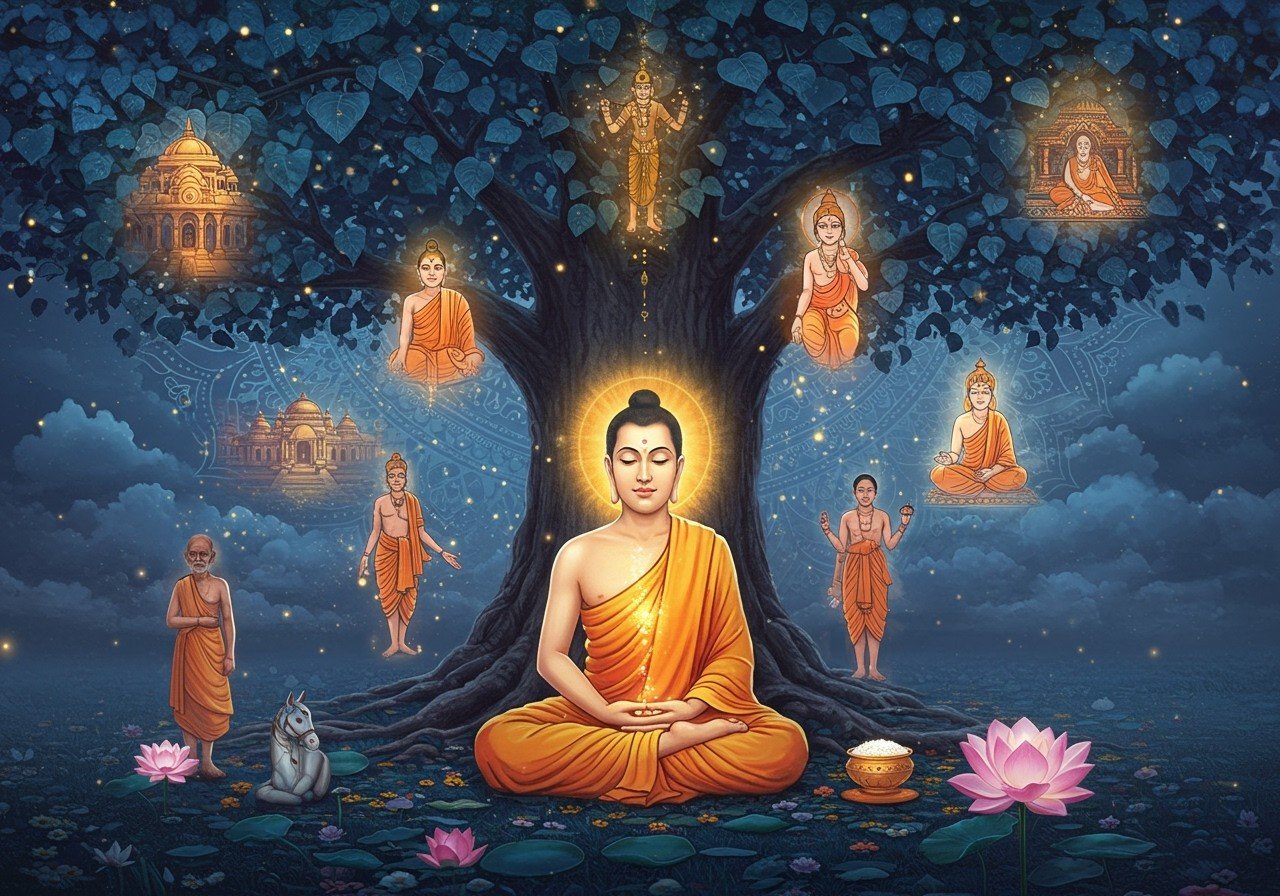
In the vibrant tapestry of Indian spirituality, the life of Siddhartha Gautama, the Buddha, stands out as a beacon of wisdom and compassion. His transformation from a sheltered prince to an enlightened teacher has profoundly shaped Buddhism and continues to inspire countless individuals across the globe. Delving into his life story allows us to grasp the depth of his teachings and their enduring relevance in the modern world.
Gautama Buddha’s Early Life
Born in Lumbini, Nepal, around the 6th-4th century BCE, Siddhartha Gautama entered the world as a prince of the Shakya clan. His father, King Śuddhodana, shielded him from the hardships of life, hoping he would become a powerful ruler. Siddhartha received an education encompassing arts, sciences, and martial arts, living a life of privilege and ease. His marriage to Yasodhara and the birth of their son, Rahula, further solidified his seemingly destined path of royalty. However, these early experiences unknowingly laid the groundwork for his eventual quest for spiritual understanding.
The Catalyst for Change: The Four Sights
Siddhartha’s sheltered existence took a dramatic turn upon encountering the “Four Sights”: an old man, a sick person, a corpse, and an ascetic. These encounters shattered his illusion of a world free from suffering, revealing the impermanence of life and the inevitability of decay and death. Disturbed by these realities, he felt a growing discontent with his opulent life. This pivotal moment spurred him to renounce his royal status and family, embarking on a quest for profound truth and liberation from suffering.
The Path to Enlightenment: A Middle Way
Siddhartha’s search for enlightenment initially led him to extreme ascetic practices. However, he realized that such severe self-denial was not the path to true understanding. He then discovered the “Middle Way”—a balanced approach avoiding the extremes of self-indulgence and self-mortification. Through deep meditation under the Bodhi tree in Bodh Gaya, Siddhartha attained enlightenment, becoming the Buddha, “The Awakened One.” He realized the Four Noble Truths and the Eightfold Path, the core principles of his teachings.
The Teachings of the Buddha: A Path to Liberation
The Buddha’s teachings revolve around understanding and overcoming suffering. The Four Noble Truths explain the nature of suffering, its origin, its cessation, and the path to its cessation. The Eightfold Path provides a practical framework for achieving liberation, encompassing right understanding, thought, speech, action, livelihood, effort, mindfulness, and concentration. Central to his philosophy are the concepts of impermanence (aniccā), suffering (dukkha), and non-self (anattā).
Spreading the Dharma: The Buddha’s Later Life
After attaining enlightenment, the Buddha dedicated his life to sharing his insights with others. He traveled extensively throughout the Indian subcontinent, delivering sermons and establishing monastic communities. His first sermon at Sarnath, known as “Setting in Motion the Wheel of Dharma,” marked the beginning of his teaching journey. He emphasized the importance of personal experience and direct insight in realizing the truth.
The Buddha’s Legacy: A Timeless Message
The Buddha passed away in Kushinagar around the 6th-4th century BCE, leaving behind a legacy that continues to shape the lives of millions. His teachings on compassion, mindfulness, and the pursuit of wisdom remain remarkably relevant in today’s world, offering a path to inner peace and liberation from suffering.
Exploring the Life of the Buddha: Frequently Asked Questions
What was Siddhartha Gautama’s upbringing like? Siddhartha was raised in a luxurious environment, shielded from suffering by his father. This upbringing ultimately contributed to his later quest for spiritual meaning after he witnessed the realities of life outside the palace walls.
What motivated Siddhartha to leave his home? Witnessing old age, sickness, death, and an ascetic led Siddhartha to realize the universality of suffering. This realization prompted him to abandon his privileged life and seek a path to enlightenment.
Can you elaborate on Siddhartha Gautama’s family? Siddhartha was born into the Shakya clan, his father being King Śuddhodana and his mother Queen Māyā. He married Yaśodharā and they had a son, Rāhula. His family background played a significant role in shaping his early life experiences.
How did Siddhartha Gautama attain enlightenment? Through years of spiritual seeking, including ascetic practices and deep meditation, Siddhartha attained enlightenment under the Bodhi tree. This transformative experience marked his becoming the Buddha.
Embrace Buddha’s Teachings with Sacred Items from Poojn.in
Deepen your spiritual practice and create a serene meditation space with authentic Buddhist items from Poojn.in. Our curated collection includes:
- Exquisite Buddha Statues: Discover a variety of pure brass and copper Buddha statues in various meditation poses, perfect for inspiring mindfulness and reverence.
- Traditional Meditation Accessories: Enhance your meditation practice with traditional meditation cushions and mats, designed for comfort and support during extended meditation sessions.
- Soothing Incense: Create a calming atmosphere with genuine sandalwood incense sticks, known for their soothing fragrance and ability to enhance focus.
Poojn.in is committed to providing high-quality, authentic products to support your spiritual journey. Visit Poojn.in today to explore our full collection or contact our customer service for personalized guidance.


